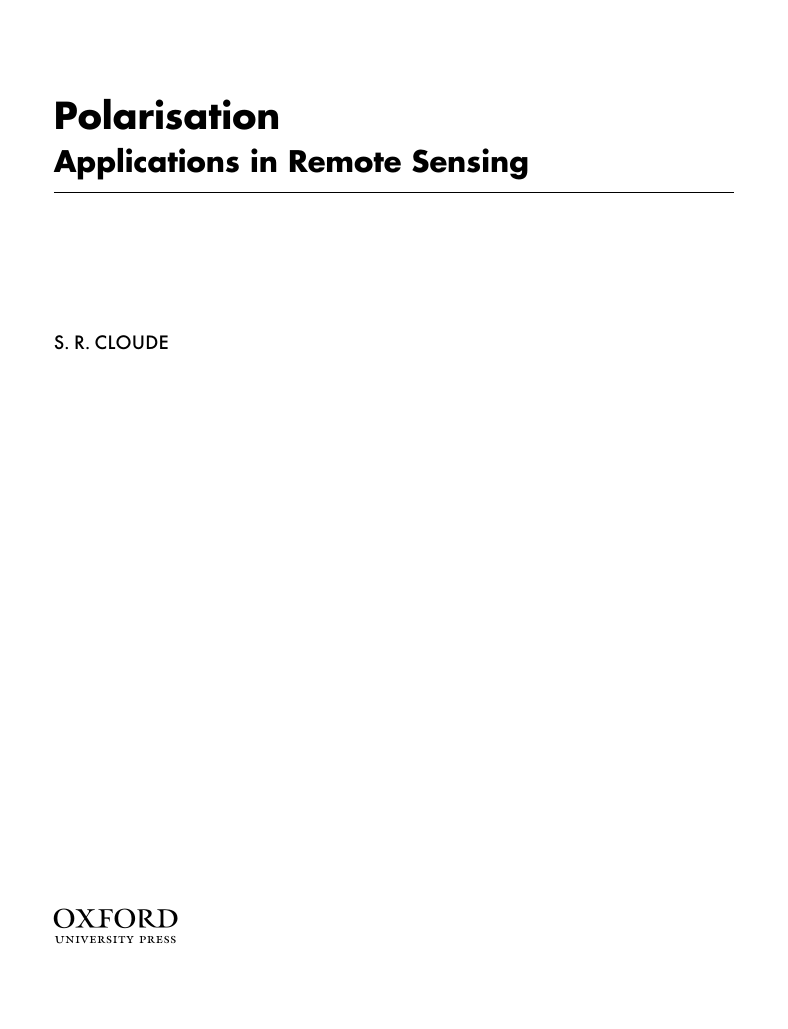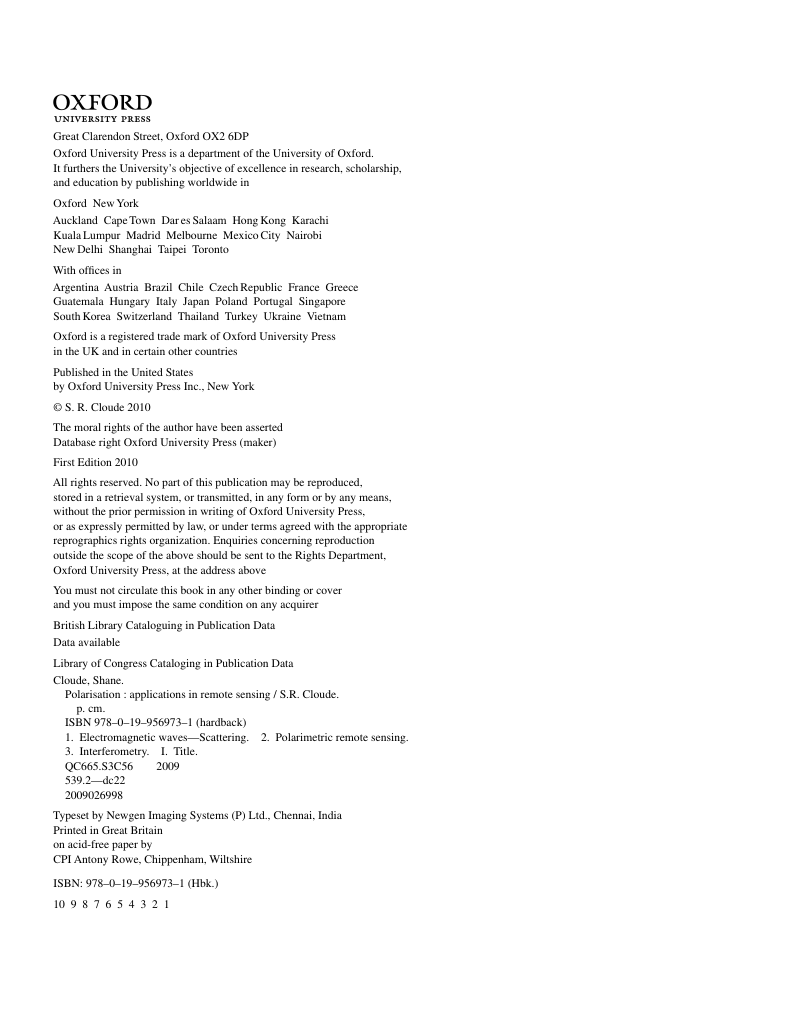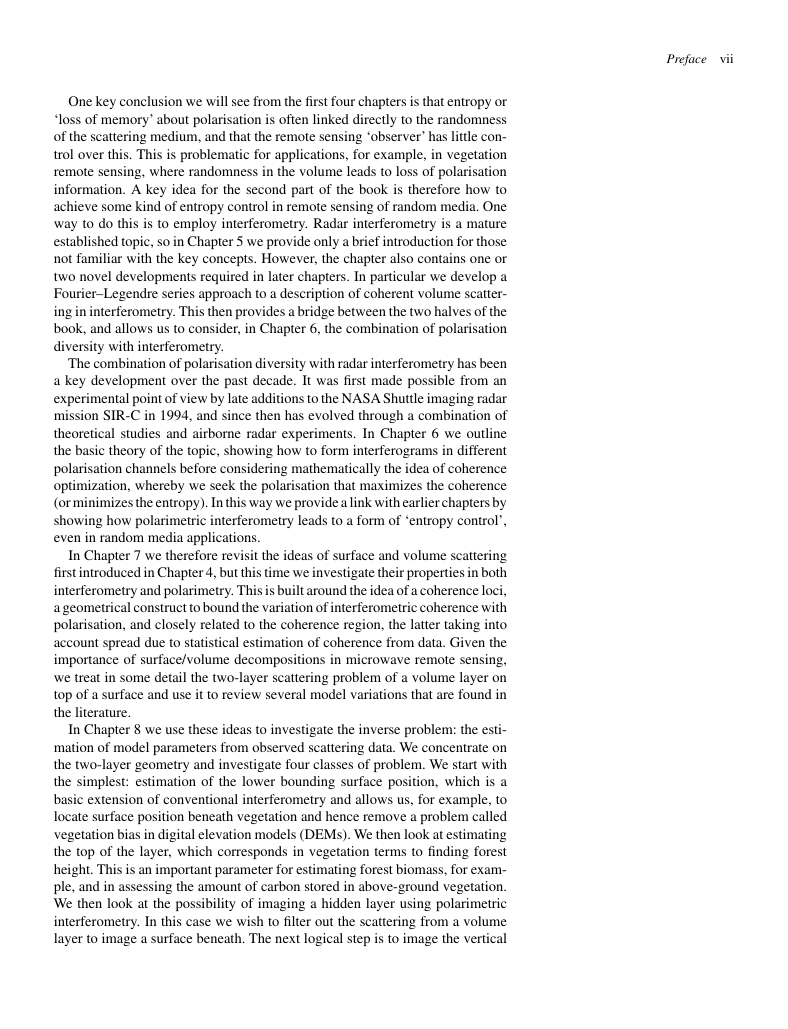�
POLARISATION: APPLICATIONS IN REMOTE SENSING
This page intentionally left blank
�
Polarisation
Applications in Remote Sensing
S. R. CLOUDE
1
�
3
Great Clarendon Street, Oxford OX2 6DP
Oxford University Press is a department of the University of Oxford.
It furthers the University’s objective of excellence in research, scholarship,
and education by publishing worldwide in
Oxford New York
Auckland Cape Town Dar es Salaam Hong Kong Karachi
Kuala Lumpur Madrid Melbourne Mexico City Nairobi
New Delhi Shanghai Taipei Toronto
With offices in
Argentina Austria Brazil Chile Czech Republic France Greece
Guatemala Hungary Italy Japan Poland Portugal Singapore
South Korea Switzerland Thailand Turkey Ukraine Vietnam
Oxford is a registered trade mark of Oxford University Press
in the UK and in certain other countries
Published in the United States
by Oxford University Press Inc., New York
© S. R. Cloude 2010
The moral rights of the author have been asserted
Database right Oxford University Press (maker)
First Edition 2010
All rights reserved. No part of this publication may be reproduced,
stored in a retrieval system, or transmitted, in any form or by any means,
without the prior permission in writing of Oxford University Press,
or as expressly permitted by law, or under terms agreed with the appropriate
reprographics rights organization. Enquiries concerning reproduction
outside the scope of the above should be sent to the Rights Department,
Oxford University Press, at the address above
You must not circulate this book in any other binding or cover
and you must impose the same condition on any acquirer
British Library Cataloguing in Publication Data
Data available
Library of Congress Cataloging in Publication Data
Cloude, Shane.
Polarisation : applications in remote sensing / S.R. Cloude.
p. cm.
ISBN 978–0–19–956973–1 (hardback)
1. Electromagnetic waves—Scattering. 2. Polarimetric remote sensing.
3. Interferometry.
QC665.S3C56
539.2—dc22
2009026998
I. Title.
2009
Typeset by Newgen Imaging Systems (P) Ltd., Chennai, India
Printed in Great Britain
on acid-free paper by
CPI Antony Rowe, Chippenham, Wiltshire
ISBN: 978–0–19–956973–1 (Hbk.)
10 9 8 7 6 5 4 3 2 1
�
Preface
An alternative title considered for this book was Which Way is Up? Questions
and Answers in Polarisation Algebra. On advice it was rejected in favour of a
more conventional approach. Still, it is a good question. Which way is up? A
question with a literal scientific interpretation—namely, how to define vertical
in a free reference frame for electromagnetic waves, but also one with a col-
loquial interpretation about the best route to progress. At a technical level this
book is concerned with the answer to the former, but hopefully will serve to
promote in the reader some idea of the latter. It arises from over twenty years’
personal experience of research in the topic, but also through the privilege of
having met and collaborated with many of those who made fundamental con-
tributions to the subject. Much of this original work remains, unfortunately,
scattered in the research literature over different years and journals. This book,
then, is an attempt to bring it all together in a didactic and coherent form suitable
for a wider readership.
The book aims to combine—I believe for the first time—the topics of wave
polarisation and radar interferometry, and to highlight important developments
in their fusion: polarimetric interferometry. Here indeed we shall see that the
whole is greater than the sum of the parts, and that by combining the two we
open up new possibilities for remote sensing applications.
It is intended as a graduate level text suitable for a two-semester course for
those working with radar remote sensing in whatever context, but is also aimed
at working scientists and engineers in the broad church that is remote sensing.
Hopefully it will also appeal to those working in optical physics—especially
polarimetry and light scattering—and to mathematicians interested in aspects
of polarisation algebra.
Before reviewing the structure of the book, certain spelling requires clarifi-
cation. Polarisation or Polarization? The usual response is that British English
uses ‘s’, and American ‘z’. However, in this text we reserve spelling with ‘s’ for
the property of a transverse wave, while we use ‘z’ for the effect of electromag-
netic fields on matter. Hence waves remain polarised while matter is polarized.
In this way we take advantage of both forms.
Chapter 1 first provides an introduction to the physical properties of polarised
waves using the formal machinery of electromagnetic wave theory. The idea is
to provide motivation and a foundation for many concepts used in later chapters.
For example, the concepts of matrix decomposition, the use of the Pauli matrices
in wave propagation and scattering and, most importantly of all, the idea of
using unitary matrices to form a bridge between mathematical descriptions of
polarisation in terms of complex and real numbers, are all introduced in this
chapter. This is in addition to the more prosaic elements of polarisation theory,
such as the polarisation ellipse, the Stokes vector, and the Poincaré sphere, all
of which are covered. The chapter is organized around three main themes: how
�
vi Preface
to generate polarised waves and describe them in various coordinate systems,
how to represent the propagation of such waves between two points A and
B, and finally how to describe their interaction with particles via the process
of scattering. The idea throughout is to develop the concept of the ‘memory’
imprinted on a wave of its original polarisation and how this may be lost through
the complexities of propagation and scattering.
This idea of ‘loss of memory’ is developed further in Chapter 2, where
stochastic effects are treated in more detail. We start by considering the
coherency matrix of a wave and show how it leads to the wave dichotomy;
namely, two different ways in which to model the loss of polarisation informa-
tion to noise. This then opens up a new approach to describing the effects of
noise, not just on a freely propagating wave but also on a scattering system as a
whole via the concept of scattering entropy. Entropy is an important concept in
this book and here we show how entropy from a generalized coherency matrix
description can be formally linked to the classical Mueller/Stokes formulation.
This leads, for example, to a formal test for isolating the set of physical Mueller
matrices from the much wider set of 4 × 4 real matrices—something which
is quite difficult to do from the Mueller calculus itself. We also show how
the entropy concept can be applied to multiple dimensions, including general
bistatic or forward scattering, so freeing it from the important but special case
of backscatter widely used in radar.
Chapter 3 was in many ways one of the most difficult to write. Here we
attempt to apply the ideas of entropy to electromagnetic models of surface
and volume scattering (where polarization becomes important). What makes it
difficult is the sheer scope of the problem. There are so many such models that
they perhaps deserve a whole book to themselves. Instead we concentrate on
a few simple models to convey the key ideas, and also link to developments
in later chapters on decomposition theory and interferometry. Given that the
main application of this book is to microwave scattering, we further concentrate
on low-frequency models, whereby the wavelength is quite large compared to
the size of the scattering feature, which has the further advantage that closed-
form analytic formulae are available to calculate, for example, the scattering
entropy. Having discussed this, we provide some treatment of high-frequency
models and how they differ in polarisation properties from the low-frequency
approach.
Chapter 4 deals with the important new topic of decomposition theorems.
These now have widespread application in microwave remote sensing, and
basically seek to isolate or separate various contributions in a mixture of scat-
tering processes. The most important such idea is to separate surface from
volume scattering. Microwaves have the ability to penetrate vegetation and
other land cover (snow,
ice, and so on) and thus generally incorporate a
complicated mixture of processes in the scattered signal. Decomposition the-
orems are an attempt to separate these and hence improve interpretation and
parameter retrieval in quantitative remote sensing applications. There are two
basic classes of decomposition–coherent and incoherent–and within each class
several authors have proposed different models. Here we provide a unified
survey of all such methods and illustrate their various strengths and weak-
nesses by linking their physical structure to the ideas developed in earlier
chapters.
�
Preface
vii
One key conclusion we will see from the first four chapters is that entropy or
‘loss of memory’ about polarisation is often linked directly to the randomness
of the scattering medium, and that the remote sensing ‘observer’ has little con-
trol over this. This is problematic for applications, for example, in vegetation
remote sensing, where randomness in the volume leads to loss of polarisation
information. A key idea for the second part of the book is therefore how to
achieve some kind of entropy control in remote sensing of random media. One
way to do this is to employ interferometry. Radar interferometry is a mature
established topic, so in Chapter 5 we provide only a brief introduction for those
not familiar with the key concepts. However, the chapter also contains one or
two novel developments required in later chapters. In particular we develop a
Fourier–Legendre series approach to a description of coherent volume scatter-
ing in interferometry. This then provides a bridge between the two halves of the
book, and allows us to consider, in Chapter 6, the combination of polarisation
diversity with interferometry.
The combination of polarisation diversity with radar interferometry has been
a key development over the past decade. It was first made possible from an
experimental point of view by late additions to the NASA Shuttle imaging radar
mission SIR-C in 1994, and since then has evolved through a combination of
theoretical studies and airborne radar experiments. In Chapter 6 we outline
the basic theory of the topic, showing how to form interferograms in different
polarisation channels before considering mathematically the idea of coherence
optimization, whereby we seek the polarisation that maximizes the coherence
(or minimizes the entropy). In this way we provide a link with earlier chapters by
showing how polarimetric interferometry leads to a form of ‘entropy control’,
even in random media applications.
In Chapter 7 we therefore revisit the ideas of surface and volume scattering
first introduced in Chapter 4, but this time we investigate their properties in both
interferometry and polarimetry. This is built around the idea of a coherence loci,
a geometrical construct to bound the variation of interferometric coherence with
polarisation, and closely related to the coherence region, the latter taking into
account spread due to statistical estimation of coherence from data. Given the
importance of surface/volume decompositions in microwave remote sensing,
we treat in some detail the two-layer scattering problem of a volume layer on
top of a surface and use it to review several model variations that are found in
the literature.
In Chapter 8 we use these ideas to investigate the inverse problem: the esti-
mation of model parameters from observed scattering data. We concentrate on
the two-layer geometry and investigate four classes of problem. We start with
the simplest: estimation of the lower bounding surface position, which is a
basic extension of conventional interferometry and allows us, for example, to
locate surface position beneath vegetation and hence remove a problem called
vegetation bias in digital elevation models (DEMs). We then look at estimating
the top of the layer, which corresponds in vegetation terms to finding forest
height. This is an important parameter for estimating forest biomass, for exam-
ple, and in assessing the amount of carbon stored in above-ground vegetation.
We then look at the possibility of imaging a hidden layer using polarimetric
interferometry. In this case we wish to filter out the scattering from a volume
layer to image a surface beneath. The next logical step is to image the vertical
�
















 2023年江西萍乡中考道德与法治真题及答案.doc
2023年江西萍乡中考道德与法治真题及答案.doc 2012年重庆南川中考生物真题及答案.doc
2012年重庆南川中考生物真题及答案.doc 2013年江西师范大学地理学综合及文艺理论基础考研真题.doc
2013年江西师范大学地理学综合及文艺理论基础考研真题.doc 2020年四川甘孜小升初语文真题及答案I卷.doc
2020年四川甘孜小升初语文真题及答案I卷.doc 2020年注册岩土工程师专业基础考试真题及答案.doc
2020年注册岩土工程师专业基础考试真题及答案.doc 2023-2024学年福建省厦门市九年级上学期数学月考试题及答案.doc
2023-2024学年福建省厦门市九年级上学期数学月考试题及答案.doc 2021-2022学年辽宁省沈阳市大东区九年级上学期语文期末试题及答案.doc
2021-2022学年辽宁省沈阳市大东区九年级上学期语文期末试题及答案.doc 2022-2023学年北京东城区初三第一学期物理期末试卷及答案.doc
2022-2023学年北京东城区初三第一学期物理期末试卷及答案.doc 2018上半年江西教师资格初中地理学科知识与教学能力真题及答案.doc
2018上半年江西教师资格初中地理学科知识与教学能力真题及答案.doc 2012年河北国家公务员申论考试真题及答案-省级.doc
2012年河北国家公务员申论考试真题及答案-省级.doc 2020-2021学年江苏省扬州市江都区邵樊片九年级上学期数学第一次质量检测试题及答案.doc
2020-2021学年江苏省扬州市江都区邵樊片九年级上学期数学第一次质量检测试题及答案.doc 2022下半年黑龙江教师资格证中学综合素质真题及答案.doc
2022下半年黑龙江教师资格证中学综合素质真题及答案.doc